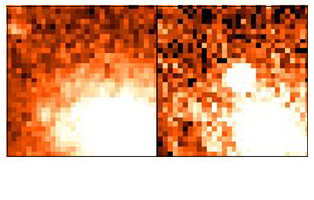The team of scientists at Yale University, Lawrence Berkeley National Laboratory and the link chain of laboratories in France have developed a tool to measure distances from Earth to supernovae with high accuracy. never seen.
Supernova explosion of type 1a is the explosion of stars that helps detect dark energy in 1998. Astronomers continue to use supernova to understand the end of the process of expanding the universe. In recent years, astronomers have been able to measure the distance to these 'standard candles' with an error of only 10% , and similarly, can only test new forms of dark energy in a certain limit.
These supernovae are so bright that we can see even when they are billions of light years away. Each supernova has an inherent brightness level, so astronomers can measure the brightness of these stars when viewed from Earth to determine the actual distance from that supernova to our planet. . However, each star has a certain geological structure, which leads to the fact that they appear brighter or darker when exploding, so the measured distance is not always completely accurate.
The research team began searching for supernova in the past few years in a survey of the largest supernova ever named Nearby Supernovae Factory. To find supernovae, the world's largest QUEST optical camera group, designed and developed at Yale University. So far, researchers have discovered 185 supernovae , of which 58 supernovae have been analyzed for recent research.
 Baltay and the team used the QUEST camera to find 185 supernovae as in the picture. On the left is a picture of the galaxy, in the middle is a photograph of a supernova explosion a month later. (Photo: Charles Baltay / Yale University)
Baltay and the team used the QUEST camera to find 185 supernovae as in the picture. On the left is a picture of the galaxy, in the middle is a photograph of a supernova explosion a month later. (Photo: Charles Baltay / Yale University)
'Measuring distances to supernovae has always been a major challenge for astronomy since the discovery of dark energy,' Charles Baltay, professor of physics at Yale University, one of the authors of statements, statements. 'To understand how light energy works in a newly formed universe, we need to conduct measurements with greater precision.'
According to a report that will be published in the upcoming issue of Astronomy & Astrophysics, the team now has a more accurate way of measuring distances to these supernovae. Using a telescope in Hawaii to analyze the light signals of each supernova, they looked at the texture of each supernova. After analyzing the inherent brightness level, the researchers will be able to determine the distance from the Earth to that supernova with an accuracy of over 60%.
In the near future, the group hopes to continue analyzing the remaining near supernovae, which can test the predictions of the history of dark energy as well as its activity in the newly formed universe. 'In science, it is interesting that you will not know what is about to be discovered,' Baltay said. 'The good news is that the supernovae we've studied so far are very helpful.'
Other members of the Yale research team include David Rabinowitz, Richard Scalzo and Will Emmet.
 Van Allen's belt and evidence that the Apollo 11 mission to the Moon was myth
Van Allen's belt and evidence that the Apollo 11 mission to the Moon was myth The levels of civilization in the universe (Kardashev scale)
The levels of civilization in the universe (Kardashev scale) Today Mars, the sun and the Earth are aligned
Today Mars, the sun and the Earth are aligned The Amazon owner announced a secret plan to build a space base for thousands of people
The Amazon owner announced a secret plan to build a space base for thousands of people